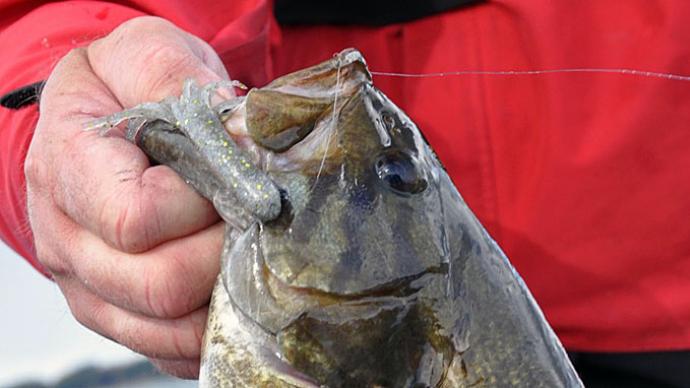
Gitzits or tube baits are more commonly known and are undoubtedly the strangest looking lure yet to be invented.
My introduction to them came through my bass club on Long Island. A founder member of the club, Joe Modashel, and his wife Alicia, known to many who fish the area, have mastered the technique of fishing these baits over the years. I am sure Joe would admit that Alicia outfishes him with this lure. Joe, if it is any consolation, I know how you feel. My Linda does precisely the same thing to me!
Well, to get back to the Gitzit. Let me begin by explaining how this bait can be used.
Flipping
This is the method used by Denny Brauer to win the 1998 Bassmaster Classic. Using a spinning rod and reel, loaded with 15-pound test, I tie a 2/0 Gamakatsu wide gap hook directly to the line and fish the larger 3 1/2-inch baits with a small lead weight (called a GITZIT Glider) inside the lure. The lead is there to add to the overall weight and assists in bait presentation. I prefer 1/8-ounce, but I will reduce the weight to 1/16-ounce if conditions are tough.
A tip here for those of you unfamiliar with this type of fishing. Place the lure in your hand and close your eyes. Hop the bait up and down in your hand and "feel" the weight of the lure. I guarantee that when you pitch or flip the lure into the water and remember the feel of the total lure weight, you will be able to detect bites more easily.
Presentation under docks or weed edges should be made with the same delicate entry you would use for a jig and pork: the less surface commotion, the better. Allow the bait to fall naturally, giving extra line from the spool if needed. Often the bait will be taken on the fall, so watch your line. Once the bait reaches the bottom, feel the weight of the lure with your rod and twitch the bait slowly back towards you. If the lure feels heavy or seems to be stuck, set the hook! I would rather stick a submerged pad or piece of structure than lose a fish.
Hot colors for the island include but are not restricted to: black, black/blue, black with red flake, pumpkinseed with black flake, green pumpkin, green with a cinnamon tail, and watermelon with black flake.
Pitching
Similar rules apply here as they do for flipping. Casting a distance with a lure like this will make a quiet entry into the water more difficult. The best technique is to raise the rod tip just as the lure is about to enter the water. This slows the bait in the air and will lessen the impact on landing. Casting a longer distance than you would have for flipping requires additional attention to the line. Feeling the bite can also be aided by running the line over a finger in front of the reel. Subtle movements are often felt with this method when retrieving the line.
Carolina Rigging
I see faces frown at the thought! So let me share this with you. Carolina rigging a Gitzit can often pick up the larger fish that hold deep and are wise to worms and lizards. I have fooled many 3 pound plus fish into taking a Gitzit fished this way, so please do not overlook it when the fishing gets tough.
Texas-style
Finally, Gitzits can also be fished Texas-style with the weight on the nose of the lure. I will allow the weight to run freely on the line in heavy weeds. I find this eliminates a lot of snagging in the weeds. If the weeds have open areas, peg the weight with a toothpick, making sure the excess is snipped off. I will not use a weight over 1/4-ounce as it affects the lure action.
Stuart is a pro angler who fishes the B.A.S.S. Invitational circuit, the REDMAN Northeastern trail, and the FOXWOODS trail. He is sponsored by Bullet Weights, G.Loomis, Gamakatsu, Lake Hawk, Chevy Trucks, Hawg-ly Lures, Uncle Josh, Ike-Con Fishing Tackle, Snap-Set Spinnerbaits, Map-Trap, Stamina Components, and Power Troll Batteries.




